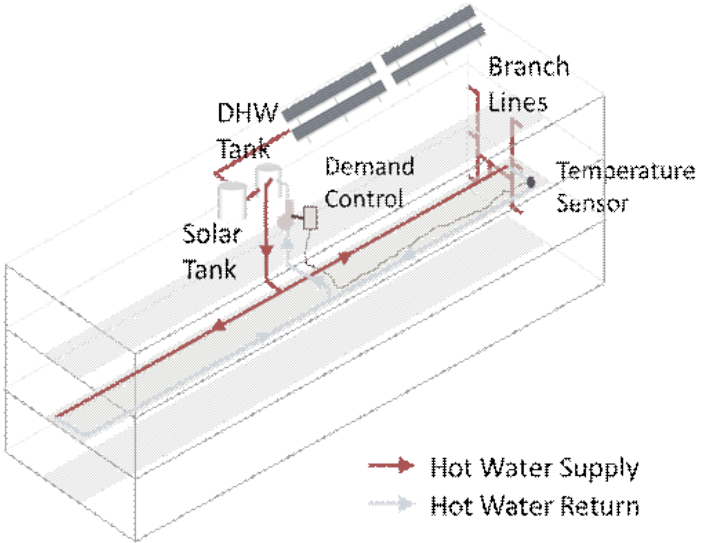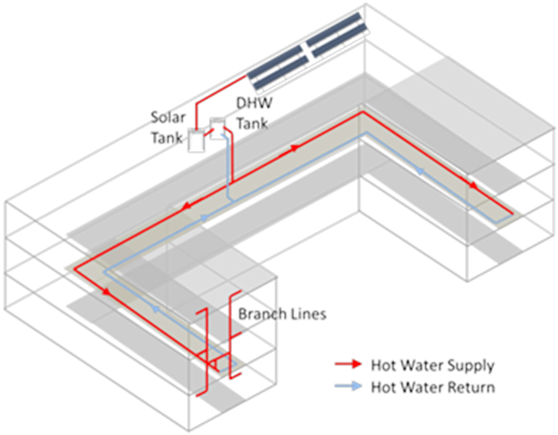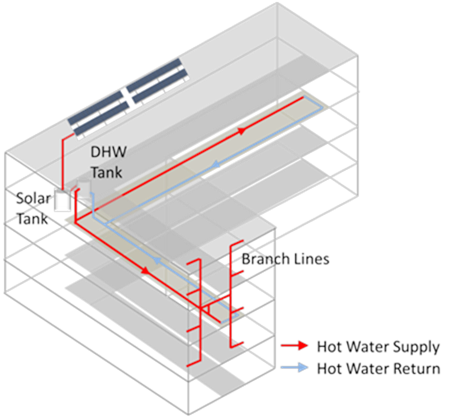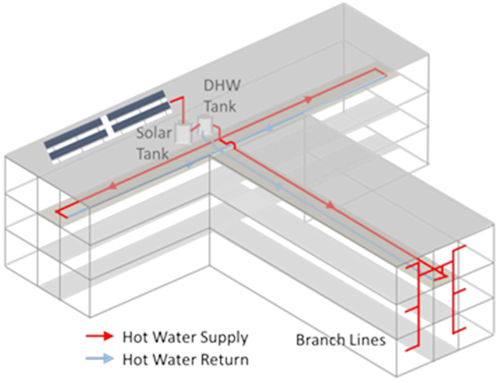
There are three options to comply with the prescriptive water heating requirements for newly constructed single dwelling units. For all three options, the water heater must comply with the mandatory requirements for water heaters. (See Section 5.1 5.3.) If a recirculation distribution system is installed, only demand recirculation systems with manual control pumps are allowed. The three options are described below.
Option 1: Install a natural gas or propane instantaneous water heater with an input rating of 200,000 BTU per hour or less.
Option 2: Install a natural gas or propane storage water heater with a rated storage volume 55 gallons or less and an input rating of 105,000 BTU per hour or less. The dwelling unit must meet all of the requirements for Quality Insulation Installation (QII), which requires that a HERS Rater verify QII has been designed and installed in accordance with Energy Standards. The user must also do one of the following:
1. Use a compact hot water distribution design, which requires a HERS Rater to verify that the system has been designed and installed in accordance with the Energy Standards (See Reference Appendix RA4.4.16.)
2. Insulate all domestic hot water pipes which requires that a HERS Rater verify that the pipe insulation is designed and installed in accordance to the Energy Standards.
Option 3: Install a natural gas or propane storage water heater with a rated storage volume greater than 55 gallons and an input rating of 105,000 BTU per hour or less. The user must also do one of the following:
1. Insulate all domestic hot water pipes which requires that a HERS Rater verify that the pipe insulation is designed and installed in accordance to the Energy Standards.
If Option 2 is pursued, in which a gas storage water heater that is 55 gallons or less is installed instead of a gas instantaneous water heater, then QII will need to be considered at the start of the design process, and it must be coordinated with several players including the designer, the general and/or insulation contractor, and the HERS Rater. QII will be included as part of the first building inspection, typically well in advance of the actual water heater being installed.
For more information on QII compliance requirements see Chapter 3 (Building Envelope) of this compliance manual and RA3.5 of the Reference Appendix. QII is required for Option 2 but not for Option 3. That is, if a natural gas or propane water heater less than 55 gallons is installed, the building must also comply with the QII requirements.
The minimum federal efficiency requirement for storage water heaters greater than 55 gallons is more stringent than storage water heaters that are 55 gallons or less.
For more information on HERS-verified domestic hot water pipe insulation requirements, see Section 5.6.2.5 of this chapter. The Reference Appendix contains the requirements for the proper installation of pipe insulation (see RA4.4.1, RA4.4.3 and RA4.4.14). The compliance requirements in Reference Appendix RA4.4.3 state that all the piping in a hot water distribution system must be insulated from the water heater to each fixture or appliance following the proper installation provisions in Reference Appendix RA4.4.1. RA 4.4.14 states that HERS inspection is needed to verify that all hot water piping in nonrecirculating systems is insulated correctly. A summary of the mandatory pipe insulation requirements is described in Section 5.3.5.1. HERS-verified pipe insulation is included in Options 2 and 3 described above. If a user does not want to insulate pipes, he or she can choose to use a compact hot water distribution design instead.
For more information on HERS-verified compact hot water distribution design, see Section 5.6.2.4. HERS-verified compact hot water distribution designs are included in Options 2 and 3 described above. If a user does not use a compact design, he or she can comply with HERS-verified pipe insulation requirements instead.
Any other water heating system that differs from the three options described in this section does not meet the prescriptive requirements. Other systems can be installed if using the performance approach as described in Section 5.5.
For additions, the prescriptive requirements described above apply only if a water heater is being installed as part of the addition. The prescriptive requirements apply only to the space that is added, not the entire building.
For alterations where an existing water heater is being replaced, the water heater must meet the mandatory equipment efficiency requirements. Pipe insulation requirements do not apply to alteration for portion of the pipes that are inaccessible. See Chapter 9 for more detailed explanation for the water heating alteration requirements.
As mentioned, there are three options for users to comply prescriptively with the water heating requirements for newly constructed single dwelling units, including additions. All options must also comply with the applicable mandatory requirements in §110.3 and §150.0 (j and n).
1. A system with a single natural gas or propane instantaneous water heater:
a) A gas input rating less than or equal to 200,000 BTU/h.
b) No supplemental storage tank is installed.
c) If using a recirculation distribution system, only demand recirculation systems with manual control pumps are allowed.
2. A system with a single gas or propane storage water heater with a rated storage volume of 55 gallons or less must have:
a) A gas input rating of 105,000 BTU/h or less.
b) The dwelling unit must meet all of the requirements for QII as specified in the Reference Appendix RA3.5, and either
i. Have HERS-verified insulation on all domestic hot water piping (see RA4.4.1, RA4.4.3 and RA4.4.14)
ii. Have a HERS-verified compact distribution system design (see RA4.4.16).
c) If using a recirculation distribution system, only demand recirculation systems with manual control pumps are allowed.
3. A system with a single gas or propane storage type water heater with a rated storage volume of greater than 55 gallons must have:
a) A gas input rating 105,000 BTU/h or less, and either
i. Have HERS-verified insulation on all domestic hot water piping (see RA4.4.1, RA4.4.3 and RA4.4.14)
ii. Have a HERS-verified compact distribution system design (see RA4.4.16).
b) If using a recirculation distribution system, only demand recirculation systems with manual control pumps are allowed.
Example 5-4−Single-family with multiple water heaters
Question:
A newly built 6,000-ft² single family residence has three gas storage gas water heaters (40-gallon, 30-gallon and a 100-gallon unit with 80,000 BTU/h input). Does it comply?
Answer:
In most cases, multiple water heaters will result in greater energy consumption than the standard design case (one water heater for a new single-family home). As such, a performance calculation is required since the system does not meet the standard requirements and must be shown to meet the water energy budget. The energy budget for the standard design building is determined by applying the mandatory and prescriptive requirements to the proposed design building. See §150.1(b)1 for more details on energy budgets and performance standards.
Example 5-5-Single-family home with a point-of-use distribution system
Question:
A newly built 1,800 ft² single family residence has two identical 30-gallon gas storage water heaters and a distribution system that meets the point-of-use criteria. Does this system comply?
Answer:
Because there are two water heaters, this system does not meet the standard prescriptive water heating systems requirements of §150.1(f)8, regardless of the distribution system. To evaluate this design, it must be modeled using the performance approach.
Example 5-6 − Alterations
Question:
If my house has an electric-resistance water heater and I plan to upgrade my water heater, do I need to install a gas instantaneous or gas storage water heater?
Answer:
No, if natural gas is not already connected to the building, then an electric water heater that meets the requirements of California’s Appliance Efficiency Regulations can replace the existing water heater. If installing new piping to the water heater then you will need to comply with the mandatory pipe insulation requirements. See Section 5.3.5.1 for more information on pipe insulation requirement and Chapter 9 for more information on alterations.
Example 5-7− Additions
Question:
I am building an addition to my home that will be a self-contained apartment. Do I need to comply with the prescriptive requirements?
Answer:
If the addition will include a water heater, or if it will be connected to the existing hot water distribution system to supply hot water to the apartment, then you must comply with the standards either through the prescriptive or performance path. If taking the prescriptive approach, please note that if you install a gas storage water heater, you must also comply with the QII and pipe insulation or compact design requirements (that is, HERS verification). If taking the performance approach, you can install any type of water heater as long as it 1) meets the requirements of California’s Appliance Efficiency Regulations and 2) does not exceed the water heating energy budget for the self-contained building. If you were adding only an additional room with hot water and not a self-contained dwelling, then the water heating budget would be based on the existing building plus addition. (See Section 5.5.)
Example 5-8 – Storage Water Heaters
Question:
Can I install a gas storage water heater that is more than 55 gallons instead of a gas instantaneous one?
Answer:
Yes. To comply prescriptively, you can install a gas storage water heater that holds more than 55 gallons. You must also install either HERS-verified insulation on all hot water piping OR a HERS-verified compact hot water distribution system in addition to the condensing storage water heater. You can also take the performance approach to install a gas storage water heater of any size as long as it 1) meets the requirements of California’s Title 20 Appliance Efficiency Regulations and 2) does not exceed the total energy budget for the building. (See Section 5.5.)
There are two options for using the prescriptive approach to compliance for multifamily buildings :
1. A water heater must be installed in each unit that meets the requirements for a single family building.
2. A central gas or propane fired water heater or boiler.
The water heater must have an efficiency that meets the requirements in Sections 110.1 and 110.3 in the standards (as 'listed in Table 5-5). In 'addition, if a central recirculation system is installed, it shall be installed with demand recirculation controls and a distribution layout with at least two recirculation loops. These prescriptive rules were developed based on studies that found that recirculation pipe heat loss is a major component of energy loss within a central hot water system. Pipe heat loss is affected by the pipe surface area, pipe insulation level, and the temperature difference between the hot water and ambient air. The motivation behind having two loops is to reduce recirculation pipe sizes, thus pipe surface area. This measure reduces energy use and piping materials associated with recirculation systems. Central water heating systems with eight or fewer dwelling units are exempted from needing two recirculation loops.
5.4.2.1 Dual-Loop Recirculation System Design
A dual-loop design is illustrated in Figure 5-6. In a dual-loop design, each loop serves half of the dwelling units. According to plumbing code requirements, the pipe diameters can be downsized compared to a loop serving all dwelling units. The total pipe surface area is effectively reduced, even though total pipe length is about the same as or somewhat greater than that of a single-loop design. For appropriate pipe sizing guidelines, please refer to the Universal Plumbing Code.

Figure 5-6 provides an example of how to implement dual loop design in a low-rise multifamily building with a simple layout. In this example, the water heating equipment is in the middle of the top floor with each recirculation loop serving exactly half of the building. The recirculation loops are located in the middle floor to minimize branch pipe length to each dwelling unit. The figure also illustrates how the solar water heating system and demand control are integrated.
For buildings with complicated layouts, how to create and locate recirculation loops heavily depends on building geometry. In general, the system should be designed to have each loop serve an equal number of dwelling units to minimize pipe sizes. For systems serving buildings with distinct sections, for example, two wings in an L-shaped building, it is better to dedicate a separate recirculation loop to each of the sections. Very large buildings and buildings with more than two sections should consider using separate central water heating systems for each section. In all cases, simple routing of recirculation loops should be used to keep recirculation pipes and runouts as short as possible. Figure 5-7 provides dual-loop recirculation system designs in buildings with complicated shapes.



Location of water heating equipment in the building also needs to be carefully considered to properly implement the dual-loop design. The goal is to keep overall pipe length as short as possible. As an example, for buildings in regular shapes, locating the water heating equipment at the center of the building footprint rather than at one end of the building helps minimize the pipe length needed to connect the water heating equipment to the two loops. If a water heating system serves several building sections, the water heating equipment would preferably nest between these sections.
With the new prescriptive solar water heating requirement this cycle, it is especially important to consider the integration between the hot water recirculation system and the solar water heating system. Based on feedback from industry stakeholders, most solar water heating systems are configured only as a preheater of the primary gas water heating equipment. In other words, recirculation hot water returns are usually plumbed back to the gas water heating storage tanks, not directly into the solar tank. This means recirculation loop designs should be based mostly on the building layout and are relatively independent of the solar water heating system. On the other hand, gas water heating equipment and solar tanks should be located close to each other to avoid heat loss from pipes connecting the two systems. The preferred configuration is to place both the gas water heating equipment and solar tanks on the top floor near the solar collector so that the total system pipe length can be reduced. As noted before, minimizing pipe length helps reduce domestic hot water system energy use as well as system plumbing cost.
5.4.2.2 Demand Recirculation Control
The prescriptive requirement for domestic hot water systems serving multiple dwelling units requires the installation of a demand recirculation control to minimize pump operation and heat loss from pipes. Please note that they are different from the demand controls used in single dwelling units. Demand controls for central recirculation systems operate by sensing hot water demand and recirculation return temperatures. The temperature sensor should be installed at the farthest end of the recirculation loop close to the last branch pipe.
Any system not meeting these prescriptive requirements must instead meet the standard design building energy budget, that is established by the energy efficiency performance of a gas instantaneous water heater that meets the requirements of California’s Title 20 Appliance Efficiency Regulations or must follow the performance compliance method for the building as a whole.
Example 5-9 - Multifamily with individual water heater
Question:
A 10-unit multifamily building has separate gas water heaters for each dwelling unit. Five units have 30-gallon water heaters, and 5 units have 50-gallon water heaters. Does this comply?
Answer:
The Energy Standards provide two prescriptive compliance paths for domestic hot water heating systems in multifamily buildings. One is to use a central water heating system. The other is to use separate gas waters for each dwelling unit, as in this example. To use this compliance method, all dwelling units must use residential water heaters or residential-duty commercial water heaters (heat input of less than 105,000 BTU/hr) with EF ratings equal or higher than corresponding Title 20 appliance standard requirements. Other requirements also pertain. See the three options in §150.1(c)8.
Example 5-10 - Multifamily recirculation system
Question:
We are building an 8-unit, 7,800 ft² multifamily building with a 200 gallon storage gas water heater with a time and temperature-controlled recirculation system that has 1 inch of insulation on all the piping. The system serves all the units. Do I have to perform calculations to show compliance?
Answer:
Water heating calculations are required since the standard design assumption uses demand recirculation for the control strategy for central recirculation. Furthermore, solar water heating is a prescriptive requirement for all multifamily buildings with central recirculation systems.
Example 5-11 - Multifamily large water heater
Question:
We
are building a 10-unit apartment building with a single large water heater. We
do not plan to install a recirculation pump and loop. Does this meet the
prescriptive requirements?
Answer:
No. Since it is unlikely that a nonrecirculating system will satisfactorily supply hot water to meet the tenants’ needs, either a recirculating system or individual water heaters must be installed to meet the prescriptive requirements. There is an exception for multifamily buildings of eight units or fewer.